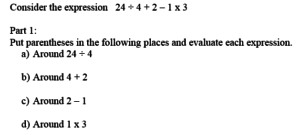Use parentheses, brackets, or braces in numerical expressions, and evaluate expressions with these symbols.
Students are able to…
- Solve word problems and expressions that require the use of order of operations, including parenthesis.
- Understand that, when evaluating expressions with different grouping symbols, such as parentheses, the operation(s) inside the grouping symbols should be solved first.
- Translate word problems into expressions and expressions into word problems.
- Explain their thinking as they use order of operations to solve different examples.
Students are able to…because teachers:
- Provide opportunities for students to make connections between numerical expressions and problem solving scenarios.
- Use problem solving scenarios that model why multiplication and division are completed before addition and subtraction.
- Provide opportunities for the students to evaluate expressions that include grouping symbols with up to 4 operations and explain how to apply order of operations.
[divider] [/divider]
Questions to ask students:
- Ask students to explain the order of operations.
- Point to or write an expression that includes division before multiplication or subtraction before addition (Example: 24 ÷ 6 × 2) and ask students to explain how to use order of operations to solve.
- Sample answer that indicates understanding: multiplication and division are interchangeable (because division is the opposite of multiplication) in order of operations, so we work left to right. In this example we should first divide 24 ÷ 6 = 4, then multiply 4 × 2 =8. (Or should have used parentheses!)
- Sample answer that indicates an incomplete understanding or a misconception: multiplication has to be done before division, (often students memorize the acronym PEMDAS or “My Dear Aunt Sally) so 6 × 2 = 12, then 24 ÷ 12 = 2.
FOR CLARIFICATION ON THE TOPIC ABOVE, WATCH THIS VIDEO AND SCROLL AHEAD TO THE 7:40 MARK.
- Ask students how changing the placement of parenthesis in an expression, will change the order in which the operations are solved.
- Sample answer that indicates understanding: The operation that is in the parenthesis will always be solved first.
- Point to an expression and ask students to think of a word problem that represents the expression.
[divider] [/divider]
FSA Notes
Cognitive Complexity Level: 1 – Recall
Achievement Level Descriptors:
Level 2: evaluates a simple numerical expression with whole numbers, using parentheses, brackets, or braces, with two procedural operations
Level 3: evaluates a numerical expression that contains a fraction, using parentheses, brackets, or braces, with three or more procedural operations
Level 4: analyzes an error in the evaluation of a numerical expression that contains parentheses, brackets, or braces
Level 5: inserts parentheses, brackets, or braces in numerical expressions to make a statement true or to equal a specified value
Assessment Limits:
- Expressions may contain whole numbers or fractions with a denominator of 10 or less.
- Expressions may not include nested parentheses.
- Multiplication cross symbol is the only acceptable symbol for multiplication. The multiplication dot may not be used.
- When grouping symbols are part of the expression, the associative property or distributive property must be found in the expression.
[divider] [/divider]
Additional Resources:
Additional in depth content knowledge:
Video: Order of Operations
Blog Post: A World Without Order (of operations)
Sample Formative Assessment Task:
